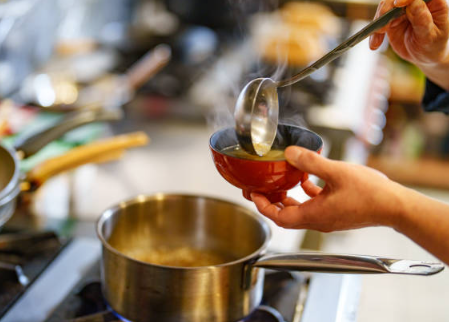Whether you’re making a creamy potato soup, a classic French onion bowl with toast, or a hearty chicken noodle, there’s just something comforting about a homemade soup that canned versions can’t touch. But sometimes, even when we do everything right, the flavor just doesn’t hit—and you’re left thinking, Why doesn’t my soup taste as good as it does in restaurants?
Good news: if your soup tastes a little flat, you’re not alone. Even professional chefs agree—bland soup is totally fixable. Below, you’ll find simple, chef-approved tips to rescue and revive any underwhelming soup and bring it back to life.

Why Does My Soup Taste Bland?
The best way to fix a bland soup is to avoid the problem before it starts. One of the most common mistakes home cooks make is waiting until the very end to season.
Instead, season as you go—with salt added in layers every time you introduce a new ingredient. This gives the soup time to build complex flavor.
Also, taste frequently as you cook (especially once the vegetables are tender) so you can make adjustments early, not just at the finish line.
Besides under-seasoning, a few other factors can lead to dull-tasting soup:
-
Using water instead of broth. Unless you’re making a flavor-forward broth (like miso or bone broth), water just doesn’t have enough depth. Always use a good-quality stock—preferably homemade or a low-sodium store-bought option so you can better control the salt.
-
Dumping everything in at once. Sure, it’s tempting to throw all your ingredients in the pot and let them cook, but building flavor step-by-step is key. For example, sautéing onions, carrots, and celery until they’re caramelized brings out natural sweetness and creates a more flavorful base.
7 Chef-Recommended Ways to Fix a Bland Soup
Even if you’ve avoided the common mistakes, your soup might still need a little love. While it’s best to build flavor from the start, there are still plenty of ways to improve the taste at the final stage.
If your soup tastes flat, it’s usually missing one (or more) of the following:
salt, acid, umami, or fat. Try these simple fixes:
1. Reduce the Broth to Concentrate Flavor
Let your soup simmer longer, uncovered, so some of the liquid evaporates. This concentrates the flavor and makes every bite richer and deeper. Sometimes, all your soup needs is time.

2. Add More Seasoning
If reducing doesn’t help—or if you prefer a thinner soup—try adding a touch more salt or even MSG (monosodium glutamate). MSG enhances umami and adds savoriness with less sodium than salt.
3. Add Acid for Brightness
A splash of acid can work wonders. Add a bit of lemon juice, vinegar, lemon zest, or even a dab of mustard near the end of cooking to brighten the whole pot. Start with ½ teaspoon, taste, and adjust.
Pro tip: Hot sauce adds both acid and heat!
4. Boost Umami
If your soup tastes thin or lacks depth, you might be missing umami. Stir in a dash of soy sauce, miso paste, or Worcestershire sauce. Even a bit of tomato paste can deepen the flavor.
5. Add Fat for Body
If your soup feels flat or overly acidic, adding a bit of fat can round it out. Try a splash of cream, half-and-half, or whole milk. For dairy-free options, drizzle in extra virgin olive oil just before serving—it adds richness and a fresh, fruity note that lifts the whole dish.
6. Balance with a Touch of Sweetness
Not every soup needs this, but a little sweetness can mellow sharp flavors or spicy heat. A teaspoon of honey, maple syrup, or even plain sugar can round out soups like tomato, squash, or root vegetable blends. Use sparingly—you want balance, not dessert.
7. Finish with Fresh Garnishes
When in doubt, finish strong. Top each bowl with a sprinkle of fresh herbs, a dollop of Greek yogurt or sour cream, or shaved cheese. For crunch and contrast, try candied nuts, crushed crackers, or crispy shallots. A spoonful of chili crisp or pesto also adds a flavorful punch.
Final Thoughts
Bland soup happens to the best of us. But with the right finishing touches—or a few adjustments during cooking—you can transform “meh” into magical. Remember: salt smartly, balance with acid, enrich with fat, and boost depth with umami.
Even if it’s a 10-minute weeknight dinner, your soup can taste like it simmered all day.